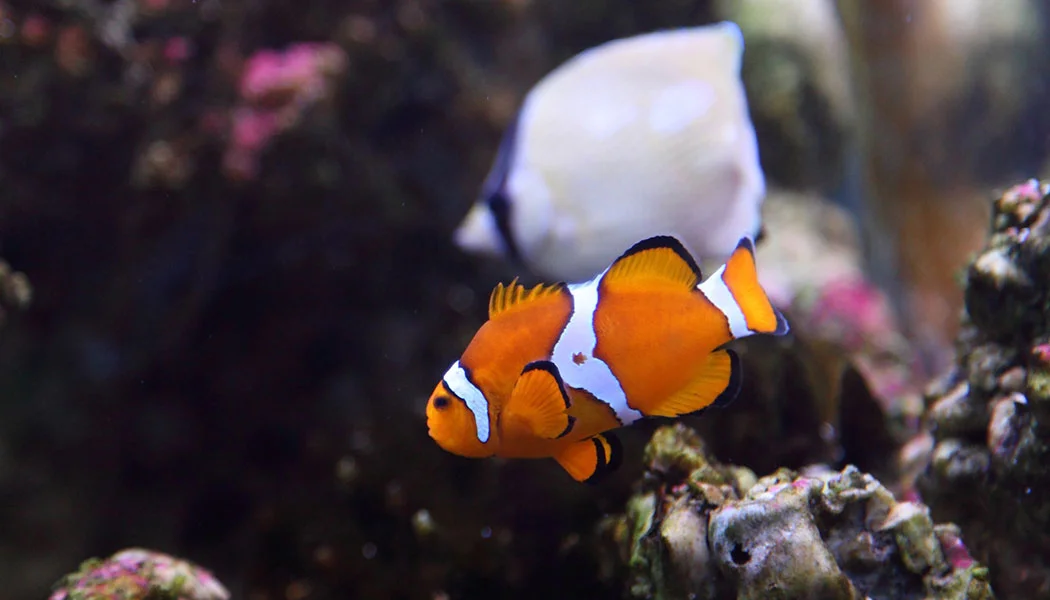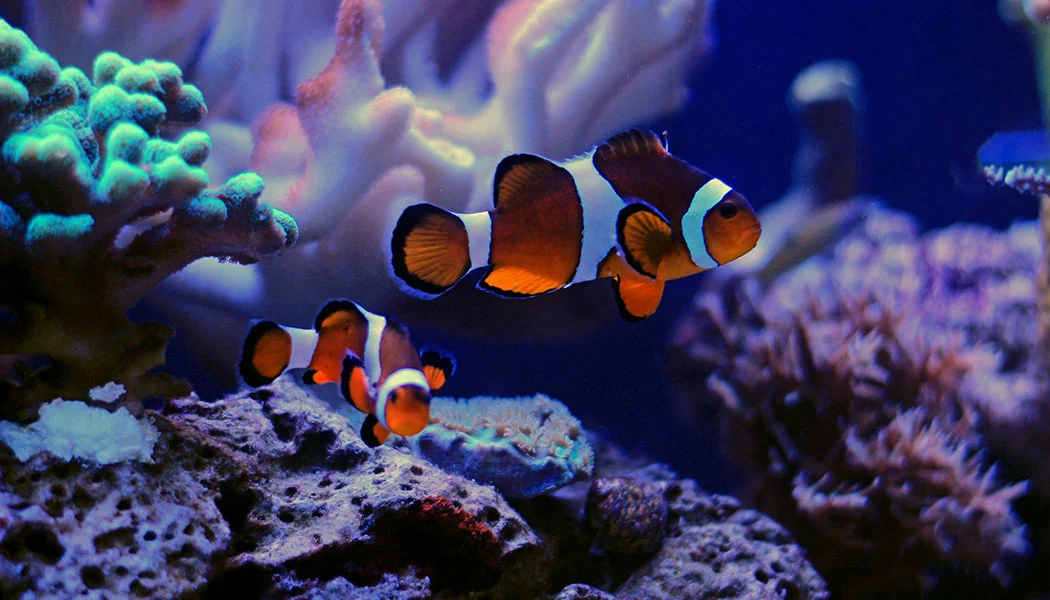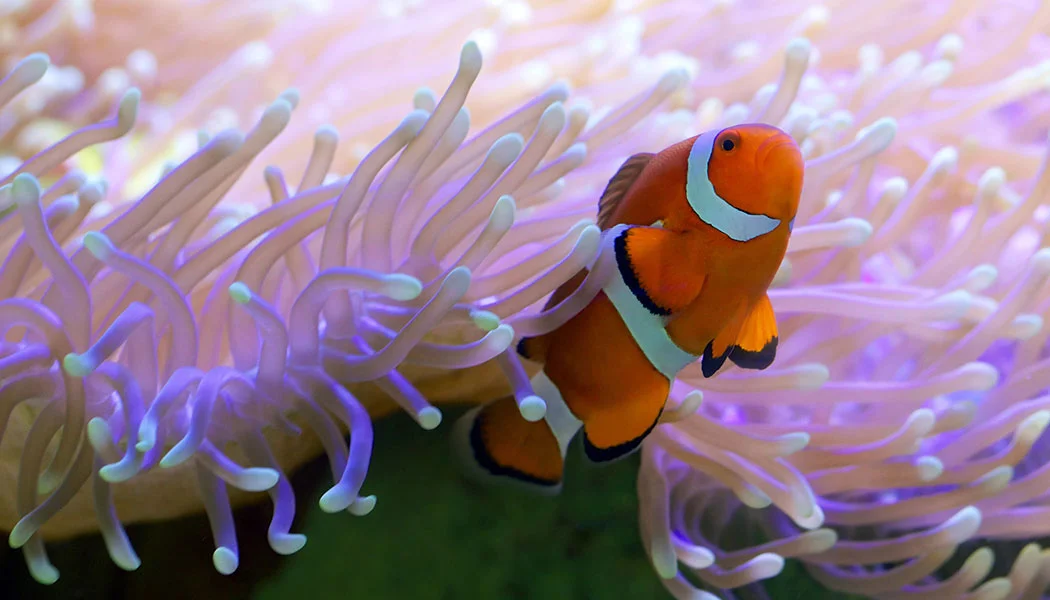Clownfish, especially the popular Amphiprion ocellaris or “Nemo,” are loved for their striking colors and fascinating behavior.
When I first set up my saltwater aquarium, a clownfish pair was the very first fish that I introduced to my tank. Now 10 years later they are still with me.
With this Clownfish care guide, you will learn how to keep them thriving. Learn how to set up a tank that copies their coral reef home, stick to good feeding times, and stop common sicknesses like ich and brooklynella.
Table of Contents
Key Takeaways
- Clownfish are popular and relatively hardy fish for saltwater aquariums.
- In aquariums, Clownfish’s lifespan can reach 10+ years.
- Understanding their natural habitat is crucial for recreating an optimal environment.
- Proper tank setup, feeding, and regular maintenance ensure their health and longevity.
Understanding Ocellaris Clownfish Care

Clownfish, most famously represented by the Amphiprion ocellaris, are one of the most popular choices for saltwater aquariums. The Ocellaris clownfish are vibrant orange and white coloration and distinctive black edging make them stand out.
They are known for their peaceful temperament, ease of care, and fascinating behavior. Clownfish typically grow to about 3-4 inches and are naturally active swimmers.
Clownfish are protandrous hermaphrodites, meaning they can change sex, with the dominant male transforming into a female if needed.
They are relatively hardy, making them suitable for home aquariums. Their natural swimming pattern, where they make quick darting movements, is both endearing and characteristic.
Natural Habitat of the Ocellaris Clownfish
Clownfish are found in warm, shallow waters of the Indian and Pacific Oceans, including the Red Sea and the Great Barrier Reef. The United States produces upwards of a million clownfish a year, but clownfish are also cultured in Indonesia, United Kingdom, Israel, Sri Lanka, Thailand, and other countries. [source]
They inhabit coral reefs and sheltered lagoons, living in symbiotic relationships with sea anemones. This mutualistic bond protects the clownfish from predators while the fish, in turn, offers the anemone nutrients through waste and increased water circulation.
The ideal aquarium should replicate this natural setting. Live rock, stable water temperatures between 74-79°F, and well-maintained salinity levels (1.020-1.025 SG) are critical for mimicking the tropical marine environment. The water pH should be maintained between 8.0 and 8.4 to ensure the clownfish’s health.
Water flow should be moderate, similar to their natural habitat, providing oxygenation without excessive currents. While anemones aren’t strictly necessary for clownfish survival, having them enhances the environment and encourages natural behaviors.
Compatibility with specific anemone species, like Heteractis magnifica or Stichodactyla gigantea, should be checked before introduction.
Choosing the Right Tank & Water Parameters
Clownfish thrive best in tanks of at least 20-30 gallons. This space allows for proper swimming room and the addition of other tankmates. If you plan to introduce multiple fish or anemones, a larger tank is advisable to avoid overcrowding. Ensuring sufficient water quality and space helps reduce stress and promote natural behaviors.
Ideal Water Parameters:
- Temperature: 74-79°F (24-26°C)
- pH: 8.0-8.4
- Salinity: 1.020-1.025 specific gravity
- Ammonia: 0 ppm
- Nitrate: <20 ppm
Maintaining stable parameters is key. Sudden changes can stress the clownfish, leading to health issues.
Water flow should be moderate, simulating their natural environment without excessive force. Equipment such as a reliable heater is essential for temperature regulation, and a quality filtration system helps keep the water clean.
Water Flow Considerations:
- Use adjustable pumps for controlled flow.
- Position pumps strategically to create natural currents.
Before adding clownfish, ensure the tank has been properly cycled, establishing beneficial bacteria to break down waste. This reduces toxic ammonia and nitrites, making the environment safe for your clownfish. Routine water testing helps maintain these conditions over time.
Aquarium Tank Setup
Setting up an aquarium requires the right equipment for creating a stable environment. Essentials include a reliable heater to maintain consistent temperatures and a high-quality filter for effective waste management. A protein skimmer aids in removing organic matter, improving water clarity and overall quality. Proper lighting supports coral and anemone health, with full-spectrum LED being optimal.
Live Rock and Substrate Selection:
- Live rock helps simulate a natural habitat and acts as a biological filter.
- Choose sand or fine gravel as a substrate to mimic the ocean floor and promote beneficial bacteria growth.
When introducing anemones, compatibility with clownfish is crucial. Anemones such as Heteractis magnifica and Entacmaea quadricolor (bubble-tip anemone) are popular choices. Place them on stable surfaces with adequate lighting to encourage healthy growth and ensure the clownfish’s comfort.
Coral Compatibility:
- Soft corals, mushrooms, and leather corals can coexist with clownfish.
- Ensure the tank’s nutrient levels support coral health without creating competition.
Clownfish Care and Maintenance

Ocellaris Clownfish care involves understanding their needs for a stable tank environment, proper feeding, and disease prevention. Regular tank maintenance, careful acclimation, and providing compatible tank mates ensure their well being.
By replicating their natural habitat and maintaining consistent water parameters, clownfish can thrive and display natural behaviors.
Acclimating Clownfish to Their New Home
Acclimating clownfish properly reduces stress and increases their chances of thriving. The drip acclimation method is preferred for its gentle approach. Start by placing the new clownfish in a clean container with the water from their transport bag. Set up a drip line using airline tubing connected to the main tank. Allow water to drip into the container at a rate of 2-4 drops per second.
This slow process gradually matches the temperature, salinity, and pH of the tank water with that of the container. The acclimation should last about an hour, depending on the differences between the transport water and tank water parameters.
Once the acclimation is complete, use a net to transfer the fish into the tank. Avoid pouring the transport water into the tank, as it may introduce unwanted contaminants. This process minimizes shock and promotes a smoother transition for the clownfish.
Clownfish Compatibility with Other Fish
Clownfish are generally peaceful and adaptable but can show territorial behavior, especially when protecting their space or an anemone. Choosing compatible tankmates is essential to create a harmonious aquarium environment.
Best Compatible Fish:
- Goby Species: Peaceful and occupy different parts of the tank, minimizing conflict.
- Damselfish: Though related, smaller and less aggressive varieties can coexist with clownfish.
- Blennies: Non-aggressive and fun to observe, making them great companions.
- Wrasses (smaller varieties): Active swimmers that share space well without bothering clownfish.
Fish to Avoid:
- Aggressive Fish: Avoid predatory or highly territorial fish like triggerfish or larger wrasse species.
- Large Angelfish: They may nip or stress clownfish, especially in smaller tanks.
- Lionfish: Predatory and could eat smaller clownfish.
Maintaining enough space in the tank helps reduce territorial behavior. Ensure each species has adequate hiding spots and distinct territories. If keeping multiple clownfish, try to pair them, as they can become aggressive toward other clownfish species.
Tips for Success:
- Introduce more passive species first, followed by clownfish.
- Monitor new additions closely for signs of stress or aggression.
Creating a balanced mix of tankmates helps maintain peace and supports natural behavior, contributing to a vibrant and engaging aquarium environment.
Clownfish Diet & Nutrition
Clownfish have varied dietary needs that include flakes, pellets, frozen, and live foods. A balanced diet ensures they receive all the necessary nutrients. Pellets and flakes fortified with vitamins should form the staple diet, while frozen and live foods like brine shrimp, mysis shrimp, and chopped seafood can be offered several times a week.
I feed my Clownfish frozen mysis shrimp and brine shrimp once per day.
Feeding Schedule:
- Adult Clownfish: 1 small meal per day.
- Juvenile Clownfish: 2 small meals daily.
Ensure the portion sizes are appropriate and that food is consumed within 2-3 minutes to avoid water contamination.
Overfeeding can lead to water quality issues and health problems such as fatty liver disease. Avoid foods that have artificial colors or fillers. Rotating the food types keeps the clownfish stimulated and ensures a range of nutrients. Proper feeding practices contribute to a healthy immune system and vibrant coloration.
Common Health Issues and Prevention
Clownfish are susceptible to certain diseases, with Ich (white spot disease) and Brooklynella (clownfish disease) being the most common. Ich appears as small white spots on the body and fins, while Brooklynella causes a milky coating on the skin, rapid breathing, and lethargy.
Signs of a Healthy Clownfish:
- Active swimming and normal behavior.
- Bright, vibrant colors.
- Healthy appetite.
Signs of a Sick Clownfish:
- Loss of appetite.
- Unusual swimming patterns or isolation.
- Faded colors or spots on the body.
Prevention is crucial for maintaining a healthy tank. Quarantine new fish for at least two weeks before introducing them to the main tank. Regular water testing helps monitor ammonia, nitrate, and nitrite levels, which, if kept stable, reduce stress.
If you have a coral reef aquarium, DO NOT USE COPPER in your display tank. Only treat diseases in a quarantine system.
Treatment Options:
- Ich: Use a copper based medication and increase tank temperature slightly to speed up the parasite’s life cycle.
- Brooklynella: Administer formalin dips or a formalin-based treatment.
Maintaining a clean, stable tank environment is key. A UV sterilizer can help reduce pathogen levels. Ensure proper aeration and water flow to promote oxygenation and reduce stress, strengthening the fish’s immune response.
Consistent observation helps catch early signs of illness and improves treatment outcomes.
Tank Cleaning and Maintenance
Regular tank maintenance is vital for a healthy environment. Establish a weekly cleaning schedule to remove debris and prevent algae buildup. Use an algae scraper or magnetic cleaner to clean the tank walls and ensure clear views. Check filters for any clogs and clean or replace filter media as needed.
Water Testing:
- Test for ammonia, nitrite, nitrate, and pH weekly.
- Maintain nitrate levels below 20 ppm to avoid stress.
Perform partial water changes of 10% every week to maintain water quality. This helps remove accumulated waste and replenish essential minerals. When performing water changes, match the temperature and salinity of the new water to that of the tank to prevent shock.
Equipment Monitoring:
- Inspect heaters, lights, and pumps for proper functioning.
- Ensure the protein skimmer is operating effectively to remove organic waste.
Frequently Asked Questions
Can clownfish live without anemones?
Yes, clownfish can live without anemones. In captivity, they adapt well and do not rely on anemones for protection like they do in the wild. They may host in other corals or objects in the tank for comfort, but their health is not dependent on anemones.
How long do clownfish live?
An Ocellaris Clownfish’s lifespan is:
- In Captivity: Up to 10-15 years with proper care.
- In the Wild: Around 6-10 years due to predators and environmental factors.
A long lifespan is achievable with stable water conditions, a balanced diet, and regular tank maintenance.
Are clownfish easy to care for?
Yes, it’s easy to care for Clownfish, especially for beginners. They are hardy fish that adapt well to different conditions. Their adaptability makes them suitable for most reef aquariums.
What size tank do I need for 2 clownfish?
A minimum tank size of 20 gallons is recommended for two clownfish. A larger tank (30 gallons or more) provides even better conditions for additional fish and decorations.
How many clownfish should be kept together?
Typically, 2 clownfish should be kept together as a bonded pair. Pairs exhibit natural behaviors and thrive better compared to solitary fish. Avoid mixing different clownfish species unless in very spacious tanks.
 Mixed Reef Tank
Mixed Reef Tank

